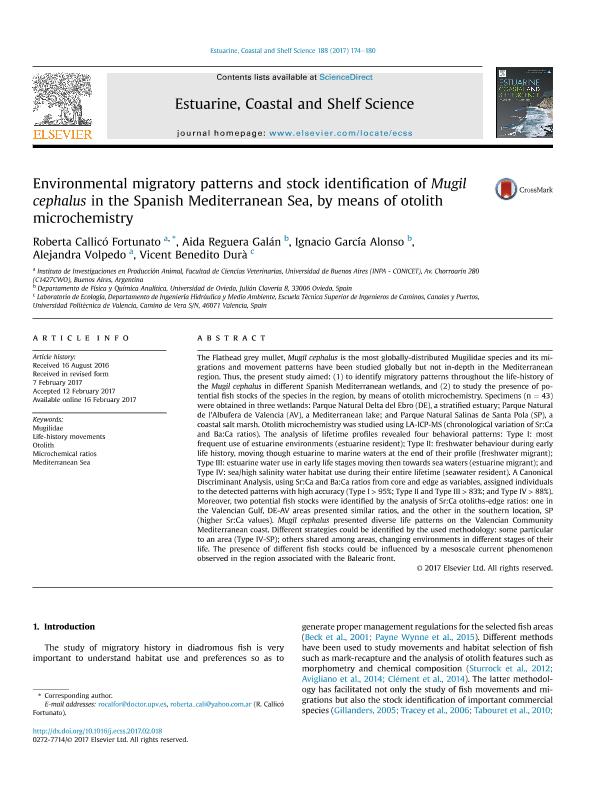Artículo
Environmental migratory patterns and stock identification of Mugil cephalus in the Spanish Mediterranean Sea, by means of otolith microchemistry
Callicó Fortunato, Roberta Glenda ; Reguera Galán, Aida; García Alonso, Ignacio; Volpedo, Alejandra
; Reguera Galán, Aida; García Alonso, Ignacio; Volpedo, Alejandra ; Dura, Vicent Benedito
; Dura, Vicent Benedito
 ; Reguera Galán, Aida; García Alonso, Ignacio; Volpedo, Alejandra
; Reguera Galán, Aida; García Alonso, Ignacio; Volpedo, Alejandra ; Dura, Vicent Benedito
; Dura, Vicent Benedito
Fecha de publicación:
02/2017
Editorial:
Academic Press Ltd - Elsevier Science Ltd
Revista:
Estuarine, Coastal and Shelf Science
ISSN:
0272-7714
Idioma:
Inglés
Tipo de recurso:
Artículo publicado
Clasificación temática:
Resumen
The Flathead grey mullet, Mugil cephalus is the most worldwide distributed Mugilidae species. Migrations and movement patterns have been studied globally but not in-depth in the Mediterranean region. Thus, two main objectives were set out in the present study: (1) to identify migratory patterns throughout the life-history of the Mugil cephalus in different Spanish Mediterranean wetlands, and (2) to study the presence of potential fish stocks of the species in the region; using otolith microchemistry as a tool of choice. Specimens (n = 43) were obtained in three wetlands: Parque Natural Delta de l?Ebro (DE), a stratified estuary; Parque Natural de l?Albufera de Valencia (AV), a Mediterranean lake; and Parque Natural Salinas de Santa Pola (SP), a coastal salt marsh. Otolith microchemistry was studied using LA-ICP-MS (chronological variation of Sr:Ca and Ba:Ca ratios). The analysis of lifetime profiles revealed four behavioral patterns: Type I: most frequent use of estuarine environments (estuarine resident); Type II: freshwater behaviour during early life history, moving though estuarine to marine waters at the end of their profile (freshwater migrant); Type III: estuarine water use in early life stages moving then towards sea waters (estuarine migrant); and Type IV: sea/high salinity water habitat use during their entire lifetime (seawater resident). A Canonical Discriminant Analysis, using Sr:Ca and Ba:Ca ratios from core and edge as variables, assigned individuals to the detected patterns with high accuracy (Type I > 95%; Type II and Type III > 83%; and Type IV > 88%). Moreover, two potential fish stocks were identified by the analysis of Sr:Ca otoliths-edge ratios: one in the Valencian Gulf, DE-AV areas presented similar ratios, and the other in the southern location, SP (higher Sr:Ca values). Mugil cephalus presented diverse life patterns on the Valencian Community Mediterranean coast. Different strategies could be identified by the used methodology: some particular to an area (Type IV-SP); others shared among areas, changing environments in different stages of their life. The presence of different fish stocks could be influenced by a mesoscale current phenomenon observed in the region associated with the Balearic front.
Archivos asociados
Licencia
Identificadores
Colecciones
Articulos(INPA)
Articulos de UNIDAD EJECUTORA DE INVESTIGACIONES EN PRODUCCION ANIMAL
Articulos de UNIDAD EJECUTORA DE INVESTIGACIONES EN PRODUCCION ANIMAL
Citación
Callicó Fortunato, Roberta Glenda; Reguera Galán, Aida; García Alonso, Ignacio; Volpedo, Alejandra; Dura, Vicent Benedito; Environmental migratory patterns and stock identification of Mugil cephalus in the Spanish Mediterranean Sea, by means of otolith microchemistry; Academic Press Ltd - Elsevier Science Ltd; Estuarine, Coastal and Shelf Science; 188; 2-2017; 174-180
Compartir
Altmétricas



